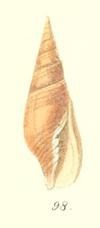Strigatella testacea
| Strigatella testacea | |
|---|---|

| |
| Sowerby's illustration accompanying Reeve's 1844 description. | |
| Scientific classification | |
| Domain: | Eukaryota |
| Kingdom: | Animalia |
| Phylum: | Mollusca |
| Class: | Gastropoda |
| Subclass: | Caenogastropoda |
| Order: | Neogastropoda |
| Family: | Mitridae |
| Genus: | Strigatella |
| Species: | S. testacea
|
| Binomial name | |
| Strigatella testacea | |
| Synonyms[1] | |
| |
Strigatella testacea is a
Taxonomy
William Broderip described the species as Mitra testacea in 1836; the holotype had been collected by Hugh Cuming.[2]
senior homonym.[1]
M. bulimoides Reeve, 1844 and M. badia Reeve, 1844 are junior synonyms of M. testacea,[5] but this has not been accepted.[6][1]
Walter O. Cernohorsky proposed that
Distribution
It has been found in the
Description
Its shell is a light reddish brown color,[8] and can grow to a length of 32 mm (1.3 in).[6]
References
- ^ a b c d e f Strigatella testacea (Broderip, 1836). Retrieved through: World Register of Marine Species on 12 December 2018.
- ^ .
- ^ a b Dohrn, H. (1860). "Description of New Species of Mitra from the Collection of Hugh Cuming, Esq". Proceedings of the Zoological Society of London. 28: 368.
- ^ Dohrn, H. (1861). "Zur Kenntniss von Mitra". Malakozoologische Blätte. 8: 134.
- ^ Tyron, Jr., George W. (1882). Nassidæ, Turbinellidæ, Volutidæ, Mitridæ. Manual of Conchology. Vol. 4. Philadelphia. p. 127; Pl. 27, Fig. 110.
{{cite book}}: CS1 maint: location missing publisher (link) - ^ a b c d Cernohorsky, Walter O. (1976). "The Mitridae of the World. Part I. The Subfamily Mitrinae". Indo-Pacific Mollusca. 3 (17): 434–435.
- .
- ^ Reeve, Lovell Augustus (1844). "Plate XIV". Monograph of the Genus Mitra. Conchologia Iconica. Vol. 2. London: Reeve, Brothers. Species 98.
Further reading
- Garrett, Andrew (1872). "List of Species of Mitridæ collected at Raratonga, Cook's Islands, with Notes, also Descriptions of new Species". Proceedings of the Zoological Society of London. 1872: 840.
- Sowerby, G. B. (1880). A Monograph of the Genus Mitra. Thesaurus Conchyliorum. Vol. 4. London: Sowerby. p. 7; Pl. 8, Fig. 103.
- Garrett, Andrew (1880). "Catalogue of the Polynesian Mitridæ, with remarks on their geographical range, station, and descriptions of supposed new species". Journal of Conchology. 3 (1): 29.
- Couturier, Martial (1907). "Étude sur les mollusques gastropodes recueillis par M. L.-G. Seurat dans les archipels de Tahiti, Paumotu et Gambier". Journal de conchyliologie. 55 (2): 132.
- Dautzenberg, Ph.; Bouge, J.-L. (1933). "Les mollusques testacés marins des éstablissements français de l'Océanie (Suite)". Journal de conchyliologie. 77 (3): 193.
